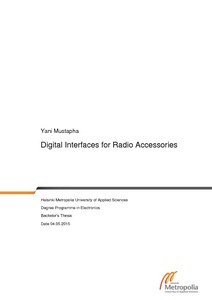Digital Interfaces for Radio Accessories
Mustapha, Yani (2015)
Lataukset:
Mustapha, Yani
Metropolia Ammattikorkeakoulu
2015
All rights reserved
Julkaisun pysyvä osoite on
https://urn.fi/URN:NBN:fi:amk-201505056150
https://urn.fi/URN:NBN:fi:amk-201505056150
Tiivistelmä
This thesis was carried out to develop a concept of how digital interfaces in radio accessory devices could be used. It aims to illustrate the benefits of digital interfaces in regards to radio accessories as well as the drawbacks. Examples of benefits are increase in features of the accessory, such as having embedded sensors, displays, video streaming, better resistance to electromagnetic interference and how fast, easily and reliably the data can be transferred to a radio or phone. Examples of drawbacks are high power consumption and design difficulty.
By means of a Raspberry Pi 2 single-board computer and a camera, a prototype device was made and video was streamed through the USB port to an Android phone. Various interfaces were considered and an explanation about why they were used was given.
The results of the research show that there can be benefits of developing digital interfaces on radio accessories. Various interfaces are available which should be used depending on the needs of the accessory. This usually depends on the type of data that needs to be transferred (audio, video, file transfer or interactive media). Currently the interfaces used in accessories are optimal for the requirements. However if higher data transfer speeds are required to stream video, audio and other data for example, developing an interface such as USB would be beneficial.
Further research was proposed on certain interfaces such as I2C and CAN to determine if it is feasible to stream audio using less wires to radios, the quality of the audio, resistance to EMI and RFI and their respective power consumption.
By means of a Raspberry Pi 2 single-board computer and a camera, a prototype device was made and video was streamed through the USB port to an Android phone. Various interfaces were considered and an explanation about why they were used was given.
The results of the research show that there can be benefits of developing digital interfaces on radio accessories. Various interfaces are available which should be used depending on the needs of the accessory. This usually depends on the type of data that needs to be transferred (audio, video, file transfer or interactive media). Currently the interfaces used in accessories are optimal for the requirements. However if higher data transfer speeds are required to stream video, audio and other data for example, developing an interface such as USB would be beneficial.
Further research was proposed on certain interfaces such as I2C and CAN to determine if it is feasible to stream audio using less wires to radios, the quality of the audio, resistance to EMI and RFI and their respective power consumption.
